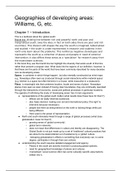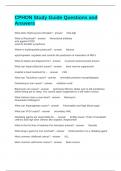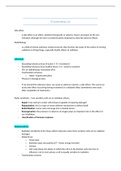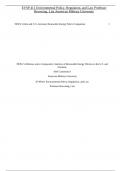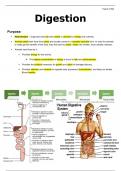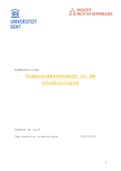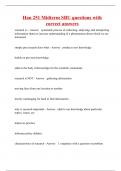Summary Mechanisms of Disease 1
Theme 1: The immune system
Introduction to the immune system
Narcolepsy: a neurological disorder linked to HLA and autoimmunity
The basic defence mechanisms of the body is organized in 3 layers:
- Physical, chemical and microbial barriers prevent pathogens to enter the body
- Innate immune system
- Adaptive immune system
Physical, chemical and microbial barriers:
Epithelia form a though impenetrable barrier which lines the outer surface and inner cavities of the
body. Various airway epithelial functions collectively form a major host defence.
Physical and chemical barriers prevent pathogens from colonizing tissues
Innate immune system:
Morphology and normal distribution of leukocytes in the blood →
,Origin of innate and adaptive immune
system:
Innate immune cells: macrophage, dendritic cell, mast cell, etc.
Adaptive immune cells: B and T-cells
,Innate immune responses delay pathogenic replication and spread until adaptive immune cells ‘take
over’
Primary and secondary lymphoid tissues: major reservoirs of naïve
and memory T and B cells.
Primary lymphoid tissues: thymus and bone marrow
Secondary lymphoid tissues: all the other lymphoid tissues
Unlike mature B cells, precursor T cells arise in the bone marrow but require additional maturation in
the thymus (LT6)
Most of secondary lymphoid tissue is localized in the gastro-intestinal tract
- Gut-associated lymphoid tissue (GALT): tonsils, adenoids, appendix, mesenteric LN and
Peyer’s patches
- Bronchial-associated lymphoid tissue (BALT): all LN draining respiratory epithelium
- Mucosa-associated lymphoid tissue (MALT): remaining more diffusely organized lymphoid
structures at all mucosal surfaces
, Macrophages residing in the marginal sinus filter pathogens from incoming lymph draining epithelia
and other tissues (B-cell area → yellow, T-cell area → blue, plasma cells → red)
Macrophages residing in the marginal sinus filter pathogens from incoming lymph draining epithelia
and other tissues
Macrophages in the spleen are
specialized in filtering free
pathogens and immune complexes
carried by erythrocytes
Langerhans cells (innate cells,
dendritic cells) in skin and mucosa
are ‘sentinel’ cells controlling T cell
priming
Adaptive immune responses are
induced by DC migrating to
draining LN
Naïve T cells enter LN either via the
blood (HEV=High Endothelial Venules) or via afferent lymph
Lymphocytes including NK cells pass through lymphatic
system, bone marrow, tissues and the blood to search for
antigen
Theme 1: The immune system
Introduction to the immune system
Narcolepsy: a neurological disorder linked to HLA and autoimmunity
The basic defence mechanisms of the body is organized in 3 layers:
- Physical, chemical and microbial barriers prevent pathogens to enter the body
- Innate immune system
- Adaptive immune system
Physical, chemical and microbial barriers:
Epithelia form a though impenetrable barrier which lines the outer surface and inner cavities of the
body. Various airway epithelial functions collectively form a major host defence.
Physical and chemical barriers prevent pathogens from colonizing tissues
Innate immune system:
Morphology and normal distribution of leukocytes in the blood →
,Origin of innate and adaptive immune
system:
Innate immune cells: macrophage, dendritic cell, mast cell, etc.
Adaptive immune cells: B and T-cells
,Innate immune responses delay pathogenic replication and spread until adaptive immune cells ‘take
over’
Primary and secondary lymphoid tissues: major reservoirs of naïve
and memory T and B cells.
Primary lymphoid tissues: thymus and bone marrow
Secondary lymphoid tissues: all the other lymphoid tissues
Unlike mature B cells, precursor T cells arise in the bone marrow but require additional maturation in
the thymus (LT6)
Most of secondary lymphoid tissue is localized in the gastro-intestinal tract
- Gut-associated lymphoid tissue (GALT): tonsils, adenoids, appendix, mesenteric LN and
Peyer’s patches
- Bronchial-associated lymphoid tissue (BALT): all LN draining respiratory epithelium
- Mucosa-associated lymphoid tissue (MALT): remaining more diffusely organized lymphoid
structures at all mucosal surfaces
, Macrophages residing in the marginal sinus filter pathogens from incoming lymph draining epithelia
and other tissues (B-cell area → yellow, T-cell area → blue, plasma cells → red)
Macrophages residing in the marginal sinus filter pathogens from incoming lymph draining epithelia
and other tissues
Macrophages in the spleen are
specialized in filtering free
pathogens and immune complexes
carried by erythrocytes
Langerhans cells (innate cells,
dendritic cells) in skin and mucosa
are ‘sentinel’ cells controlling T cell
priming
Adaptive immune responses are
induced by DC migrating to
draining LN
Naïve T cells enter LN either via the
blood (HEV=High Endothelial Venules) or via afferent lymph
Lymphocytes including NK cells pass through lymphatic
system, bone marrow, tissues and the blood to search for
antigen

